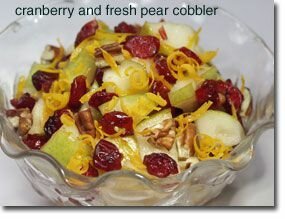August 27, 2013
Check Out What's New On Our Website
Recent
studies have shown that the skin of pears contains at least three to
four times as many antioxidant, anti-inflammatory flavonoids, and
potentially anti-cancer phytonutrients than the flesh,another reason to
choose organic pears whenever possible. Find out What's New and Beneficial About Pears.
Today's Recipe
If you don't know what to serve for dinner tonight ...
This is a wonderful after-dinner treat that provides a great
combination of flavors and health benefits to your Healthiest Way of
Eating! Cranberries, like their cousin blueberries, are one of the best
sources of health-promoting antioxidants.
Cranberry and Fresh Pear Cobbler

Prep and Cook Time: 30 minutes
Ingredients:
- 1 medium orange*
- 1/2 cup dried cranberries
- 2 tsp honey
- 1/2 ripe pear (Bosc or other firm variety)
- 1/4 cup + 2 TBS walnuts
- *Because the recipe calls for orange zest we recommend using an organic orange
- Grate enough orange rind to make 1 tsp zest and place in a mixing bowl.
- Cut the orange in half and juice both halves into the same bowl as the rind.
- Add the cranberries and honey. Mix until the honey is dissolved. Let sit for 1/2 hour to allow cranberries to soften.
- After the cranberries have softened, cut the pear into 1/4-inch cubes and add to the bowl.
- Add 1/4 cup walnuts.
- Divide the mixture into 2 dessert dishes and sprinkle each with 1 TBS of the chopped walnuts.
In-Depth Nutritional Profile for Cranberry and Fresh Pear Cobbler
Healthy Food Tip
The Latest News About Pears
Pears are a member of the rose family of plants (Rosaceae), which, in addition (of course) to roses, contains a long list of fruits including apples, apricots, cherries, chokeberry, crabapples, loquats, peaches, plums, quinces, raspberries, serviceberries, and strawberries as well as the tree nut, almonds. They are distinct from (but closely related to) the fruit we commonly call "pear apple." Some of the more commonly enjoyed varieties include: Bartlett, Bosc, Comice, Concorde, Forelle, Anjou, Seckel, and Starkrimson.
What's New and Beneficial About Pears
- For nutritional reasons, we're often advised to consume the skins of fruits. However, it's less often that research provides strong evidence in support of this advice. Recent studies have shown that the skin of pears contains at least three to four times as many phenolic phytonutrients as the flesh. These phytonutrients include antioxidant, anti-inflammatory flavonoids, and potentially anti-cancer phytonutrients like cinnamic acids. The skin of the pear has also been show to contain about half of the pear's total dietary fiber.
- In recent studies measuring risk of type 2 diabetes in U.S. women, pears have earned very special recognition. Researchers now know that certain flavonoids in food can improve insulin sensitivity, and of special interest in this area have been three groups of flavonoids (flavonols, flavan-3-ols, and anthocyanins). All pears contain flavonoids falling within the first two groups, and red-skinned pears contain anthocyanins as well. Intake of these flavonoid groups has been associated with decreased risk of type 2 diabetes in both women and men. However, a new analysis of the Nurses' Health Study has shown that among all fruits and vegetables analyzed for their flavonoid content, the combination of apples/pears showed the most consistent ability to lower risk of type 2 diabetes. We believe that this special recognition given to pears as a fruit that can help lower risk of type 2 diabetes in women is likely to be followed by future studies showing this same benefit for men.
- You've no doubt heard someone say that cloudy fruit juices containing fruit pulp provide better nourishment than clear fruit juices that have had their pulp removed through filtering. Scientists have now proven that statement to be correct with respect to pear juice. With their pulp removed, pear juices were determined to lose up to 40% of their total phenolic phytonutrients, and to have significantly reduced antioxidant capacity. "Cloudy" pear juices (technically referred to as "high turbidity" juices) emerged as the superior juice type in terms of nutrient content as well as antioxidant benefits.
Health Benefits
Pears provide numerous health benefits including:- Antioxidant support
- Anti-inflammatory benefits
- Decreased Risk of Type 2 Diabetes and Heart Disease
- Reduced Cancer Risk
Nutritional Profile
Pears are a concentrated source of phenolic phytonutrients, including hydroxybenzoic acids (chlorogenic acid, gentisic acid, syringic acid, and vanillic acid); hydroxycinnamic acids (coumaric acid, ferulic acid, and 5-caffeoylquinic acid); hydroxyquinones (arbutin), flavanols (catechin, epicatechin); flavonols (isorhamnetin, quercetin, kaempferol); anthocyanins (in red-skinned varieties, including Red Anjou, Red Bartlett, Comice, Seckel, and Starkrimson); and carotenoids (beta-carotene, lutein, zeaxanthin). Pears are a very good source of heart-healthy dietary fiber and a good source of immune-supportive vitamin C and bone-building vitamin K.For more on this nutrient-rich fruit, including references related to this Latest News, see our write-up on pears.

No comments:
Post a Comment